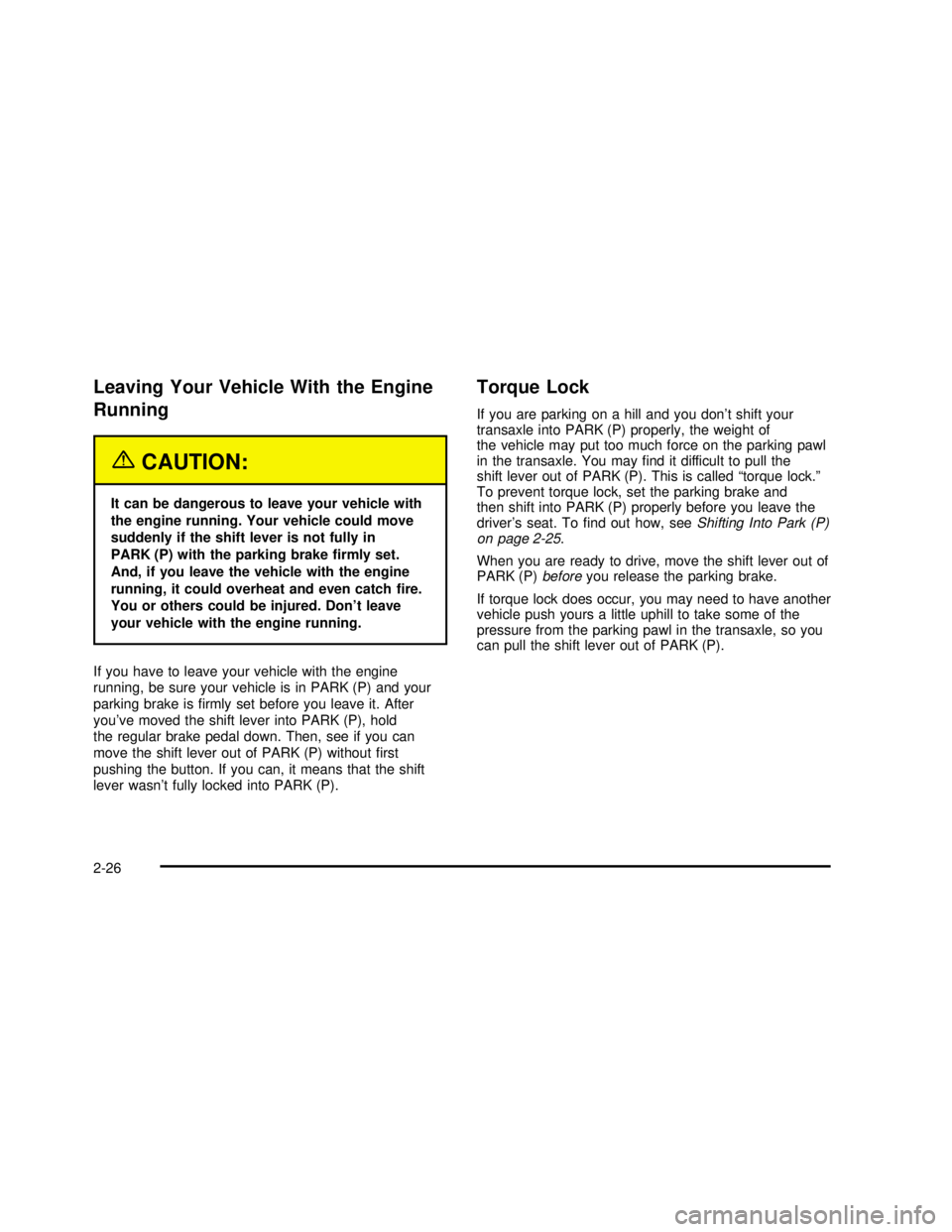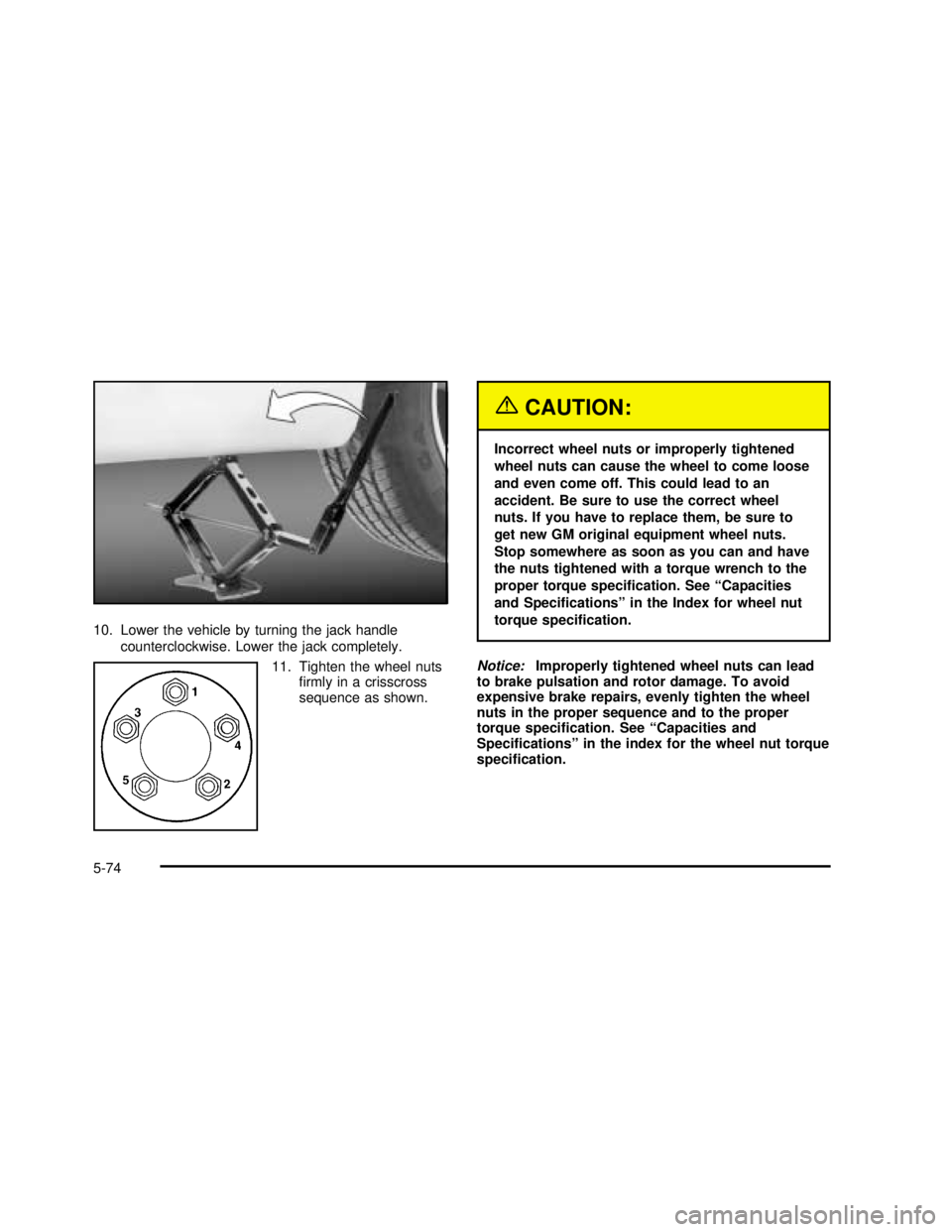2003 BUICK REGAL torque
[x] Cancel search: torquePage 88 of 344

Leaving Your Vehicle With the Engine
Running
{CAUTION:
It can be dangerous to leave your vehicle with
the engine running. Your vehicle could move
suddenly if the shift lever is not fully in
PARK (P) with the parking brakefirmly set.
And, if you leave the vehicle with the engine
running, it could overheat and even catchfire.
You or others could be injured. Don’t leave
your vehicle with the engine running.
If you have to leave your vehicle with the engine
running, be sure your vehicle is in PARK (P) and your
parking brake isfirmly set before you leave it. After
you’ve moved the shift lever into PARK (P), hold
the regular brake pedal down. Then, see if you can
move the shift lever out of PARK (P) withoutfirst
pushing the button. If you can, it means that the shift
lever wasn’t fully locked into PARK (P).
Torque Lock
If you are parking on a hill and you don’t shift your
transaxle into PARK (P) properly, the weight of
the vehicle may put too much force on the parking pawl
in the transaxle. You mayfind it difficult to pull the
shift lever out of PARK (P). This is called“torque lock.”
To prevent torque lock, set the parking brake and
then shift into PARK (P) properly before you leave the
driver’s seat. Tofind out how, seeShifting Into Park (P)
on page 2-25.
When you are ready to drive, move the shift lever out of
PARK (P)beforeyou release the parking brake.
If torque lock does occur, you may need to have another
vehicle push yours a little uphill to take some of the
pressure from the parking pawl in the transaxle, so you
can pull the shift lever out of PARK (P).
2-26
2003 - Regal OM
Page 241 of 344

Brake Wear
Your vehicle has four-wheel disc brakes.
Disc brake pads have built-in wear indicators that make
a high-pitched warning sound when the brake pads
are worn and new pads are needed. The sound
may come and go or be heard all the time your vehicle
is moving (except when you are pushing on the
brake pedalfirmly).
{CAUTION:
The brake wear warning sound means that
soon your brakes won’t work well. That could
lead to an accident. When you hear the brake
wear warning sound, have your vehicle
serviced.
Notice:Continuing to drive with worn-out brake
pads could result in costly brake repair.Some driving conditions or climates may cause a brake
squeal when the brakes arefirst applied or lightly
applied. This does not mean something is wrong with
your brakes.
Properly torqued wheel nuts are necessary to help
prevent brake pulsation. When tires are rotated, inspect
brake pads for wear and evenly tighten wheel nuts in
the proper sequence to GM torque specifications.
Brake linings should always be replaced as complete
axle sets.
SeeBrake System Inspection on page 6-15.Brake Pedal Travel
See your dealer if the brake pedal does not return to
normal height, or if there is a rapid increase in
pedal travel. This could be a sign of brake trouble.
Brake Adjustment
Every time you apply the brakes, with or without the
vehicle moving, your brakes adjust for wear.
5-41
2003 - Regal OM
Page 260 of 344

After the tires have been rotated, adjust the front and
rear inflation pressures as shown on the Tire-Loading
Information label.
Reset the Tire Inflation Monitor System. SeeTire
Pressure Monitor System on page 5-58.
Make certain that all wheel nuts are properly tightened.
See“Wheel Nut Torque”underCapacities and
Specifications on page 5-92.
{CAUTION:
Rust or dirt on a wheel, or on the parts to
which it is fastened, can make wheel nuts
become loose after a time. The wheel could
come off and cause an accident. When you
change a wheel, remove any rust or dirt from
places where the wheel attaches to the vehicle.
In an emergency, you can use a cloth or a
paper towel to do this; but be sure to use a
scraper or wire brush later, if you need to, to
get all the rust or dirt off. See“Changing a Flat
Tire”in the Index.
When It Is Time for New Tires
One way to tell when it’s
time for new tires is to
check the treadwear
indicators, which will
appear when your tires
have only 1/16 inch
(1.6 mm) or less of tread
remaining.
You need a new tire if any of the following statements
are true:
•You can see the indicators at three or more places
around the tire.
•You can see cord or fabric showing through the
tire’s rubber.
•The tread or sidewall is cracked, cut or snagged
deep enough to show cord or fabric.
•The tire has a bump, bulge or split.
•The tire has a puncture, cut or other damage that
can’t be repaired well because of the size or
location of the damage.
5-60
2003 - Regal OM
Page 274 of 344

10. Lower the vehicle by turning the jack handle
counterclockwise. Lower the jack completely.
11. Tighten the wheel nuts
firmly in a crisscross
sequence as shown.
{CAUTION:
Incorrect wheel nuts or improperly tightened
wheel nuts can cause the wheel to come loose
and even come off. This could lead to an
accident. Be sure to use the correct wheel
nuts. If you have to replace them, be sure to
get new GM original equipment wheel nuts.
Stop somewhere as soon as you can and have
the nuts tightened with a torque wrench to the
proper torque speci�cation. See“Capacities
and Speci�cations”in the Index for wheel nut
torque speci�cation.
Notice:Improperly tightened wheel nuts can lead
to brake pulsation and rotor damage. To avoid
expensive brake repairs, evenly tighten the wheel
nuts in the proper sequence and to the proper
torque speci�cation. See“Capacities and
Speci�cations”in the index for the wheel nut torque
speci�cation.
5-74
2003 - Regal OM
Page 292 of 344

Capacities and Speci�cations
Capacities and Speci�cations
ApplicationCapacities
English Metric
Air Conditioning Refrigerant R134a 2.4 lbs 1.1 kg
Automatic Transaxle
Pan Removal and Replacement
After Complete Overhaul
When draining/replacing converter, morefluid will be needed.7.4 quarts
10.0 quarts7.0 L
9.5 L
Cooling System Including Reservoir 11.7 quarts 11.0 L
Engine Oil with Filter 4.5 quarts 4.3 L
Fuel Tank 17.0 gallons 64.0 L
Wheel Nut Torque 100 lb ft 140Y
All capacities are approximate. When adding, be sure tofill to the approximate level, as recommended in this
manual. SeePart D: Recommended Fluids and Lubricants on page 6-16.
Engine Speci�cations
Engine VIN Code Displacement Firing Order
3800 V6
3800 Supercharged V6K
1231 CID 1–6–5–4–3–2
5-92
2003 - Regal OM
Page 340 of 344

Tire
Pressure Light.............................................3-35
Tire Inflation Check.........................................6-10
Tires.....................................................5-56, 5-82
Buying New Tires........................................5-61
Chains.......................................................5-65
Changing a Flat Tire....................................5-66
Compact Spare Tire
.....................................5-77
If a Tire Goes Flat
.......................................5-66
Inflation -- Tire Pressure
...............................5-57
Inspection and Rotation
................................5-59
Pressure Monitor System
..............................5-58
Uniform Tire Quality Grading
.........................5-62
Wheel Alignment and Tire Balance
.................5-63
Wheel Replacement
.....................................5-63
When It Is Time for New Tires
......................5-60
To Use the Engine Coolant Heater
....................2-20
Top of the Instrument Panel
.............................5-80
Top Strap
......................................................1-36
Top Strap Anchor Location
...............................1-37
Torque Lock
...................................................2-26
Total Weight on Your Vehicle’s Tires
..................4-37Towing
Recreational Vehicle.....................................4-31
Towing a Trailer..........................................4-35
Your Vehicle...............................................4-31
Traction
Control System (TCS)..................................4-10
Control System Warning Light.......................3-33
Full-Range Control System............................. 4-9
Low Light...................................................3-33
Trailer Brakes.................................................4-38
Transaxle
Fluid, Automatic...........................................5-20
Transaxle Operation, Automatic.........................2-21
Transmission, Transaxle, Transfer Case Unit
Repair Manual............................................7-10
Transportation Options...................................... 7-8
Trip Odometer................................................3-28
Trunk............................................................2-12
Trunk Assist Handle........................................2-13
Trunk Lock....................................................2-12
Turn and Lane-Change Signals.......................... 3-6
Turn Signal/Multifunction Lever........................... 3-5
Turn Signals When Towing a Trailer..................4-40
14
2003 - Regal OM